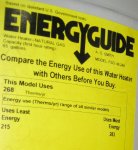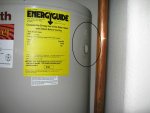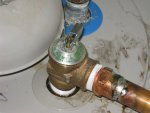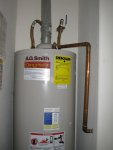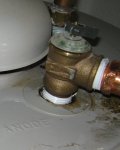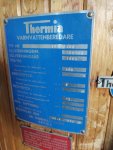Oh wow. That's just awful -- how do you just have a cache of that stuff laying around? The impact of this is going to be felt for quite a long time.
In 486 news, I bit the bullet and got a DX4 overdrive -- thankfully I got the version that works in a standard 168-pin 486 socket and not the one intended for Socket 1/OverDrive/the 487SX socket. It does work, but with my stock AMIBIOS (build date 6/6/1992) it disables the L2 cache and sees the CPU as running at 80MHz whether the 33MHz crystal or 40MHz one is inserted. I confirmed with the 40MHz crystal it's running at 120MHz but it's not stable, it won't run Quake or make it into Win95 at all. No big deal -- I'll live with 100MHz, 33MHz VLB was more stable anyway, and I found a cheap double for the original VLB super-IO card I used at the start (and broke). With a DOS utility in my AUTOEXEC to set the drive speeds, I can get almost 7MB/s out of it. Absolutely unreal for IDE on a 486-class machine. No DMA modes of course, this predates that idea, but for PIO it's really not bad. As a nice side bonus, the VLB super-IO card is less picky about CD-ROM drives, so I was able to use the one I initially picked out for this thing. Bizarrely, with the utility loaded, it even makes my video performance go up a tad -- 8.1MB/s in WinTune97 vs 6.8 without that utility. At 40MHz the card was good for 10.5MB/s, but it'll be alright I guess.
I had a 27C512 programmed with a copy of Microid Research's MR-BIOS, an aftermarket upgrade BIOS from back in the day (this one built in 1994) for the UMC480 chipset this board's equipped with. It's still on the way, but it's my hope that this will re-enable the L2 cache with the DX4 installed. Everything I've read indicates that it will. I also had my spare 28C64 reprogrammed with a reconfigured XTIDE BIOS -- this one runs in 32-bit IDE mode for VLB/PCI, as opposed to the 16-bit compatibility mode the other one I configured does for ISA/VLB/PCI.
My CT2800 blew three caps and lost an output channel last night. I should have noticed the audible whine coming out of it -- even powered off -- was only getting louder over the last month or so. Still, for a card that didn't owe me a thing, I got a lot of use out of it. I'm not throwing it away -- I might recap it someday and see if I can get it to come back to me, but I am replacing it. After shopping around I settled on the YMF719E-S based Yamaha Audician 32 Plus. It should be an excellent replacement, a bit more fiddly (drivers were apparently never Yamaha's strong suit, but they work) but overall much cleaner. Advantages include:
- SoundBlaster Pro 2.0 emulation. This can be a bit fiddly, and in some games it reverses the stereo channels, but you can usually fix it. It can even do 44KHz stereo in this mode, which notably the real SBPro can't do.
- Windows Sound System compliance. This is how I'm going to run the games that support it, since it's supposedly less fussy and cleaner. This is also how I'm going to run MPXPLAY, since it supports up to 44KHz out of these cards in that mode, and its SBPro mode only does 22KHz.
- Working WaveBlaster header and bug-free MIDI, complete with MPU-401. Long story short, most SB16s had a "hanging notes" bug. I can't explain it but if you look it up you'll see what I mean. I don't have anything MIDI to use with it yet, but I plan to acquire such things in the future, and want to be ready to use them without frustration.
- Ability to disable the Game port. I'm going to use the one on my super-IO card for joysticks/gamepads, and this port exclusively for MIDI.
- Real OPL3 baked into the YMF719 chip.
- Ability to bypass the amplification circuitry to get a pure line-level audio out. I have powered speakers anyway, and in my experience the amps used in most ISA cards kinda sucked and added too much noise to be worth it. This is configured by a jumper block.
- (Possibly untrue) I've heard that once the DOS utility initializes the card, it leaves memory entirely. This could be a big boon in freeing up some conventional memory, but then again, I loaded the VIBRA16.SYS driver high anyway.
- XGlite SoftSynth for use with Windows 95, probably won't be useful for DOS General MIDI stuff as my CPU is too slow to do all that at the same time but it ought to be nice for playing MIDIs in Media Player.
- CHEAP. This card set me back US$26, a replacement CT2800 is around US$60 on eBay.
I reinstalled IE5.5SP2 in a minimal configuration since I only need it for the runtimes now that I've installed Opera 8.5, which works better and faster, surprisingly for a browser released in 2005. The weird submenu on the Start Menu that IE5.5 added is gone in the minimal config, as long as you make sure to customize it and make sure no associations are set. This is important because it made my start menu take an extra 2-3 seconds to pop up... every time.
Overall my 486 is faster and more stable now than it ever has been. And I'm learning more about what makes these older machines tick every day. The limitations are what makes it fun to me, I guess. I have to have some patience and manage my expectations, and be glad when things work well enough. In short, I'm not treating it like a slow Pentium, I'm treating it like a 486.

